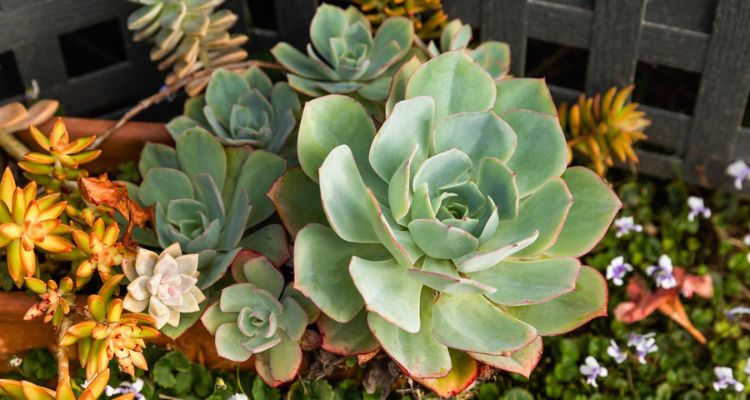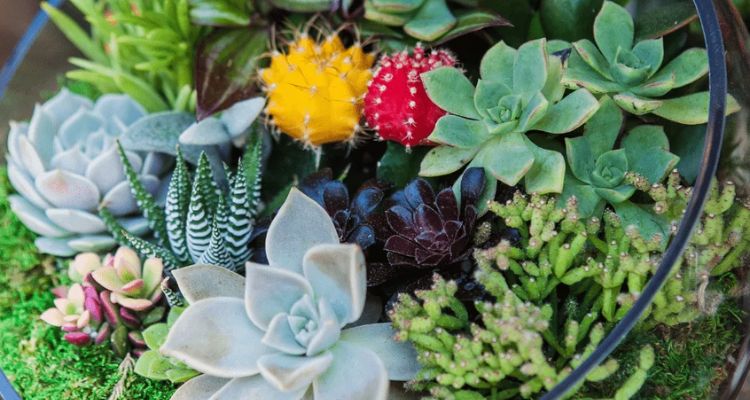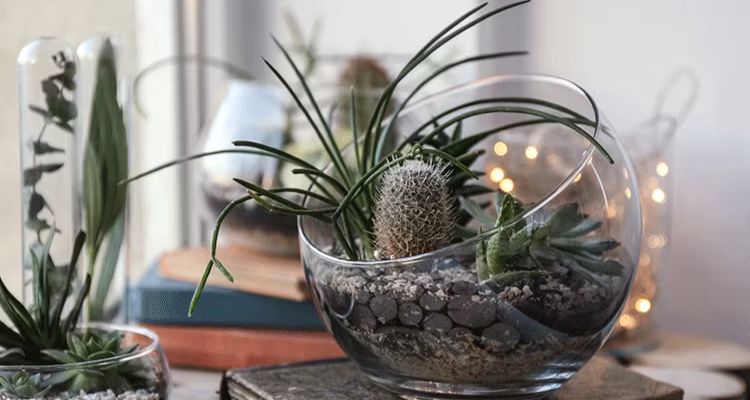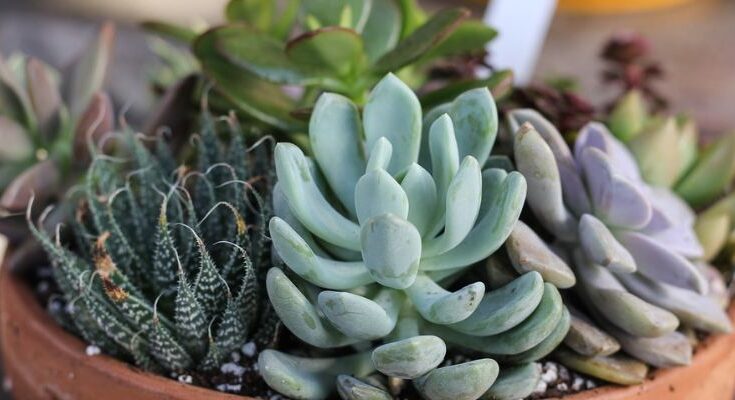|
Getting your Trinity Audio player ready...
|
Succulents, with their captivating beauty and diverse forms, have become beloved staples in both indoor and outdoor settings. In this comprehensive guide, we’ll embark on a journey through the enchanting world of succulent plants, exploring their various types and characteristics. From iconic varieties like Echeveria to lesser-known gems like Sempervivella, there’s a succulent to suit every taste and style. Join us as we unravel the secrets of these fascinating plants and discover the endless possibilities they offer for creative expression and design.
Scientific Classification of Succulent Plants
| Kingdom | Plantae |
|---|---|
| Division | Angiosperms |
| Class | Eudicots |
| Order | Caryophyllales |
| Family | Various families (e.g., Crassulaceae, Cactaceae, Aizoaceae) |
| Genus | Various genera (e.g., Echeveria, Sempervivum, Aloe, Agave) |
Types of Succulent Plants

In this comprehensive guide, we’ll delve into the enchanting world of succulent plants, exploring their various types and characteristics.
1. Echeveria
Echeverias are perhaps the most iconic of all succulents, known for their rosette-shaped leaves and vibrant hues ranging from deep purples to soft pastels. These plants thrive in well-draining soil and plenty of sunlight, making them popular choices for both indoor and outdoor gardens. With their symmetrical arrangement and delicate appearance, Echeverias add an elegant touch to any space.
2. Sempervivum (Hens and Chicks)
True to their name, Sempervivums reproduce prolifically, forming clusters of small rosettes that resemble hen and chick formations. These hardy succulents are prized for their ability to withstand harsh conditions, making them ideal for rock gardens and drought-tolerant landscapes. With a vast array of colors and textures available, Sempervivums offer endless possibilities for creative arrangements.
3. Aloe Vera
Aloe Vera is not only a popular succulent for its ornamental value but also for its medicinal properties. This versatile plant is renowned for its soothing gel, which is used to treat sunburns, cuts, and various skin ailments. With its thick, fleshy leaves and spiky edges, Aloe Vera adds a touch of exotic charm to any space while serving as a natural remedy for everyday ailments.
4. Agave
Agaves are striking succulents known for their dramatic foliage and architectural silhouettes. With their sword-like leaves and imposing presence, these plants make a bold statement in both indoor and outdoor settings. While some species produce towering flower spikes, others form compact rosettes, offering a diverse range of options for gardeners and collectors alike.
5. Crassula
Crassulas encompass a vast genus of succulent plants, ranging from tiny groundcovers to sprawling shrubs. These adaptable plants are prized for their unique foliage, which often features intricate patterns and unusual shapes. From the classic Jade Plant (Crassula ovata) to the whimsical Crassula ‘Buddha’s Temple,’ there’s a Crassula for every taste and preference.
6. Sedum
Sedums are renowned for their resilience and versatility, thriving in a wide range of conditions from full sun to partial shade. These low-maintenance succulents are perfect for beginners and seasoned gardeners alike, offering year-round interest with their colorful foliage and delicate flowers. Whether cascading from a hanging basket or tucked into a rock garden, Sedums add a touch of charm to any landscape.
7. Kalanchoe
Kalanchoes are beloved for their vibrant flowers, which range from fiery reds to soft pinks and creamy whites. While their blooms steal the spotlight, these succulents also boast attractive foliage, with many varieties featuring scalloped edges or fuzzy textures. Easy to care for and quick to propagate, Kalanchoes are popular choices for indoor gardens and container displays.
8. Haworthia
Haworthias are characterized by their intricate leaf patterns and compact growth habit, making them ideal choices for small spaces and windowsills. These charming succulents come in a variety of shapes and sizes, with some species featuring translucent “windows” that allow sunlight to penetrate deep into the plant. With their low water requirements and unique aesthetics, Haworthias are a must-have for any succulent collection.
9. Aeonium
Aeoniums are prized for their stunning rosettes of foliage, which range from deep purples to vivid greens. Unlike many other succulents, Aeoniums are dormant during the summer months and thrive in cooler temperatures, making them ideal choices for mild climates and coastal gardens. With their unique growth habit and striking coloration, Aeoniums add a touch of drama to any succulent collection.
10. Sempervivella
Sempervivellas, also known as Cobweb Houseleeks, are named for the fine web-like hairs that adorn their leaves, giving them a distinctive appearance. These charming succulents form tight rosettes of foliage, with colors ranging from soft greens to dusky purples. Sempervivellas are prized for their tolerance to cold temperatures and can withstand frost, making them excellent choices for alpine gardens and rockeries. With their intricate foliage and resilient nature, Sempervivellas are sure to delight succulent enthusiasts of all levels.
Don’t Miss: Teak Tree | Uses, Leaves, Wood, Benefits, Life Cycle & Growing
Succulent Care Guide: Tips for Thriving Plants

In this comprehensive guide, we’ll explore the essential tips and techniques for keeping your succulents happy and healthy.
1. Light Requirements
Succulents are sun-loving plants that thrive in bright, indirect light. Place your succulents near a south-facing window where they can receive ample sunlight throughout the day. However, be cautious of intense afternoon sun, which can scorch delicate foliage. If growing succulents indoors, consider supplementing natural light with grow lights to ensure adequate illumination.
2. Watering
A prevalent error often made in succulent care is excessive watering. Succulents, naturally adapted to arid conditions, thrive best with occasional, thorough watering rather than frequent light watering. Allow the soil to dry out completely between waterings, and then water thoroughly until excess moisture drains from the bottom of the pot. In winter, it’s advisable to decrease watering frequency to avoid the risk of root rot. Always use well-draining soil to prevent waterlogged conditions, which can lead to fungal diseases.
3. Soil and Potting
Succulents require well-draining soil to prevent water retention around the roots. Choose a specialized succulent or cactus mix, or create your own by mixing potting soil with perlite or coarse sand. Additionally, select pots with drainage holes to ensure proper drainage and prevent water accumulation. Avoid using pots without drainage, as they can trap excess moisture and cause root rot.
4. Temperature and Humidity
Succulents thrive in warm, dry conditions and are sensitive to cold temperatures and high humidity. Keep your succulents in a location where temperatures remain above 50°F (10°C) year-round, and provide adequate ventilation to prevent humidity buildup. During the winter months, protect succulents from drafts and cold windowsills, as sudden temperature fluctuations can stress the plants.
5. Fertilizing
Succulents have relatively low nutritional requirements and can thrive without frequent fertilization. However, applying a diluted succulent fertilizer during the growing season (spring and summer) can promote healthy growth and vibrant foliage. Use a balanced fertilizer formulated specifically for succulents, and apply according to the manufacturer’s instructions. Steer clear of over-fertilizing, as an excess of nutrients can lead to leaf burn and various other problems.
6. Propagation
Succulents are remarkably easy to propagate, making them a favorite among plant enthusiasts. Many succulents can be propagated from stem cuttings, leaf cuttings, or offsets (baby plants that form at the base of the parent plant). Simply remove a healthy cutting or offset, allow it to callus for a few days, and then plant it in well-draining soil. Keep the soil lightly moist until roots develop, and then treat the new plant as you would a mature succulent.
7. Pest and Disease Management
While succulents are relatively pest-resistant, they can occasionally fall prey to common pests such as aphids, mealybugs, and spider mites. Inspect your succulents regularly for signs of pest infestations, such as sticky residue, webbing, or distorted foliage. Treat affected plants with insecticidal soap or neem oil, and isolate heavily infested plants to prevent the spread of pests.
Don’t Miss: Rubber Tree | Facts, Uses, Wood, Seeds & Care
Creating Stunning Indoor Succulent Arrangements

In this guide, we’ll explore tips and ideas for creating stunning indoor succulent arrangements that will elevate any space.
1. Choose the Right Container
When selecting a container for your indoor succulent arrangement, consider both aesthetics and functionality. Opt for containers with drainage holes to prevent waterlogged soil and ensure the health of your plants. Additionally, choose containers that complement your interior decor style, whether it’s sleek and modern or rustic and eclectic. Terracotta pots, ceramic planters, and glass containers are popular choices for showcasing succulents indoors.
2. Select a Variety of Succulents
The key to creating visually appealing indoor succulent arrangements is diversity. Mix and match different succulent varieties with varying colors, shapes, and textures to create visual interest. Consider including rosette-forming succulents like Echeverias, trailing varieties like String of Pearls, and upright specimens like Aloe Vera or Haworthia. Experiment with different combinations until you find a balance that suits your taste and style.
3. Arrange with Purpose
Before planting your succulents, visualize the arrangement and consider the placement of each plant. Create focal points by positioning larger or more colorful specimens towards the center of the arrangement, and fill in the gaps with smaller or trailing varieties around the edges. Aim for a balanced composition with a mix of heights and shapes to create depth and dimension.
4. Planting and Potting
Once you’ve finalized your arrangement, it’s time to plant your succulents. Begin by filling the container with well-draining soil, leaving enough space for the roots of each plant. Carefully remove the succulents from their nursery pots, gently loosen the roots, and plant them in the prepared soil. Press the soil around the base of each plant to secure it in place, ensuring that the roots make good contact with the soil.
5. Care and Maintenance
Indoor succulent arrangements require minimal maintenance but benefit from regular care to keep them looking their best. Place your arrangement in a bright, sunny spot where it can receive at least six hours of indirect sunlight per day. Water your succulents conservatively, ensuring that the soil is allowed to fully dry out between each watering session. Monitor the plants for signs of overwatering or underwatering, such as yellowing leaves or shriveled foliage, and adjust your watering schedule accordingly.
Don’t Miss: Cherry Tree | Facts, Benefits, Cultural Significance, Varieties, & How to Grow
5 Benefits of Growing Succulents in Your Home & Office

1. Air Purification
One of the most notable benefits of growing succulents indoors is their ability to purify the air. Like other houseplants, succulents absorb carbon dioxide and release oxygen through photosynthesis, helping to improve indoor air quality. Additionally, some succulent varieties, such as Aloe Vera and Snake Plant, have been shown to remove harmful toxins like formaldehyde and benzene from the air, making them invaluable allies in combating indoor air pollution.
2. Low Maintenance
Succulents are renowned for their low-maintenance nature, making them ideal choices for busy homeowners and novice gardeners. These drought-tolerant plants require minimal watering and can thrive in a variety of indoor environments, from bright, sunny windowsills to dimly lit office spaces. With their ability to store water in their leaves and stems, succulents can withstand periods of neglect and require little more than occasional watering and indirect sunlight to flourish.
3. Stress Reduction
Numerous studies have shown that spending time around plants can reduce stress levels and promote feelings of relaxation and well-being. Succulents, with their soothing green foliage and calming presence, are no exception. Simply tending to your succulents, whether it’s watering them, repotting them, or simply admiring their beauty, can provide a welcome respite from the stresses of daily life and promote a sense of tranquility and mindfulness.
4. Enhanced Aesthetics
Succulents are not only beneficial for your health and well-being but also for enhancing the aesthetics of your home. With their diverse shapes, colors, and textures, succulents add visual interest and natural beauty to any indoor space. Whether arranged in a minimalist terrarium, displayed in a hanging planter, or clustered together in a succulent garden, these versatile plants can transform dull corners and empty spaces into vibrant focal points that reflect your style and creativity.
5. Year-Round Enjoyment
Unlike many outdoor plants that go dormant in the winter months, succulents provide year-round enjoyment and beauty. With their ability to thrive indoors regardless of the season, succulents offer a constant source of greenery and vitality, even during the darkest winter days. Whether it’s a snow-covered landscape or a rainy day indoors, you can always count on your succulents to brighten your spirits and bring a touch of nature into your home.
Creative Succulent Decor Ideas to Transform Your Home & Office Space

1. Terrariums and Mini Gardens
Terrariums are perfect vessels for showcasing succulents in a compact and visually appealing way. Create your own miniature garden by arranging a variety of succulent plants in a glass container filled with layers of soil, gravel, and decorative stones. Mix and match different succulent varieties to create interesting textures and contrasts, and add decorative elements like driftwood or miniature figurines for added visual interest.
2. Vertical Gardens
Vertical gardens offer a creative solution for maximizing space and adding greenery to small or narrow areas. Install a vertical garden wall indoors and fill it with a variety of trailing succulents like String of Pearls or Burro’s Tail. Alternatively, repurpose a vertical shoe organizer or hanging planter and plant succulents in each pocket or compartment for a unique and space-saving display.
3. Succulent Wreaths and Living Art
Succulent wreaths are a beautiful and seasonal decor option that can be displayed indoors or outdoors. Create your succulent wreath by attaching a variety of small succulent plants to a wire or grapevine wreath frame using floral wire or hot glue. Hang your succulent wreath on a front door, above a fireplace, or as a centerpiece for a festive and eye-catching display. Additionally, consider creating living wall art by framing a piece of corkboard or canvas and arranging succulent cuttings in a visually appealing pattern.
4. Succulent Centerpieces and Tablescapes
Succulents make stunning additions to tablescapes and centerpieces, adding a touch of natural beauty and sophistication to any dining or entertaining space. Arrange a variety of succulent plants in a shallow dish or tray and surround them with decorative accents like candles, pebbles, or seashells. Alternatively, create a living succulent centerpiece by hollowing out a pumpkin or gourd and planting succulents directly inside for a seasonal and festive touch.
5. Hanging Planters and Macrame Hangers
Hanging planters and macrame hangers are perfect for showcasing trailing succulents like String of Pearls or String of Hearts. Hang a collection of small ceramic or woven planters from a ceiling hook or wall-mounted bracket and plant succulents in each one for a cascading and eye-catching display. Alternatively, create your own macrame hanger using a cotton cord or yarn and hang it from a curtain rod or ceiling hook for a bohemian-inspired touch.
Wrapping Up
Incorporating succulents into your home decor is not only a stylish choice but also a practical one, offering numerous benefits for both your space and well-being. Whether you’re creating stunning arrangements in terrariums, hanging planters, or vertical gardens, succulents add a touch of natural beauty and elegance to any environment. With their low-maintenance nature and versatility, succulents are the perfect companions for elevating your living spaces and infusing them with tranquility, creativity, and charm. So why not embrace the beauty of succulents and transform your home into a green oasis that reflects your unique style and personality?
Don’t Miss: Desert Rose Care, Benefits, Seeds, Vastu, Leaf Health, and Pruning Tips



